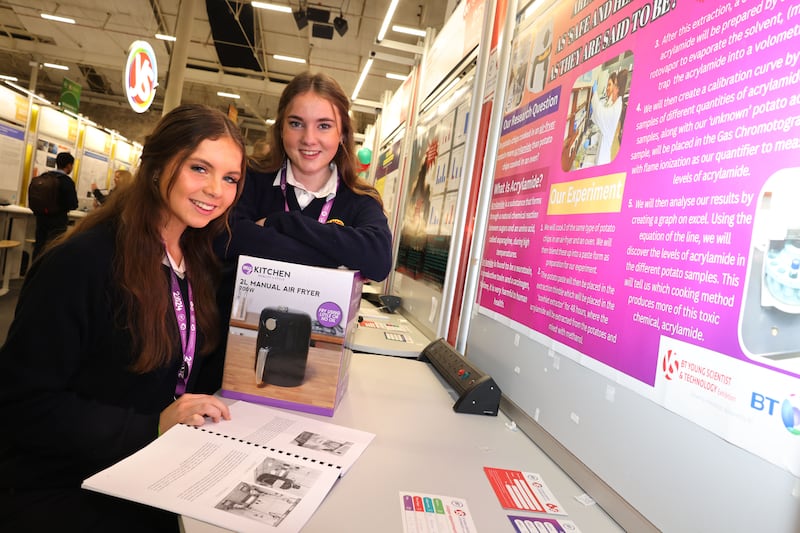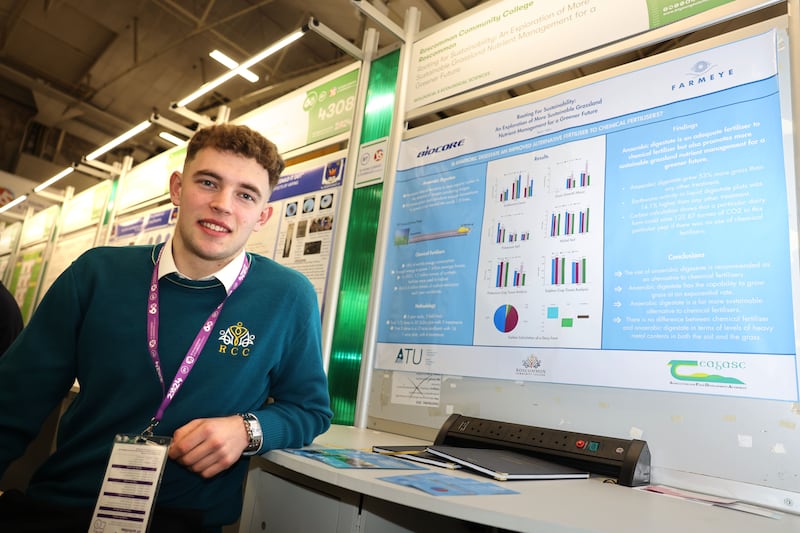The BT Young Scientist & Technology Exhibition has a history of generating exceptional entrepreneurs with businesses built on sound science, and Sean Allen, with his breakthrough on sustainable grassland nutritional management, shows signs of following suit.
The sixth year student from Roscommon Community School is back in the RDS for a third time; on each occasion building on previous research on liquid anaerobic digestate – a byproduct when food and agricultural wastes are broken down in a digester with the absence of oxygen, which also generates biomethane gas.
What’s more, the carbon-neutral fertiliser he is developing has performed exceptionally well in generating 53 per cent more grass growth compared to 10-10-20 fertiliser, and worm activity in the soil, which boosts biodiversity, is impressive.
This alternative to chemical fertiliser is not a notional success. He has scaled up large field trials and the latest one – his third – took place in a 16-acre landbank. With the help of Biocore digestate company which processes the organic waste, he has brought the venture to commercial scale assessment.
READ MORE

“My research project is to address the issue of unsustainable agricultural practices for a greener future . . .My aim is to bring it to Bord Bia and to Dáil Éireann [to outline its merits]”, Sean added.
Josh Hevey (16) and Marcus McCarthy (16) of Ardscoil Rís in Limerick are equally convinced of their green alternative to firelighters made from coffee grounds. They happened upon the idea when someone threw the byproduct of their experiment on their fire.
“We originally thought of making candles, but they were too flammable,” Marcus explained, “So we decided it was perfectly suited for firelighters.”
They tested mixes using a home-made calorimeter, such as combinations with used vegetable oil; candle wax (the binder) and lynt; the fluffy stuff generated in dryers. Using oil meant the novel product burned twice as long and 10 degrees hotter – with “only a slight smell of coffee”.
They had ample supplies of coffee and oil from a cafe attached to Ballyseedy Co-op, where Josh works, while they got candle wax from the local church.
Josh says they are not going down the patent route; “we just want to share the option with people”.
[ ‘The first of its kind’: Reporting the first Young Scientists’ Exhibition in 1965Opens in new window ]
It was not quite a eureka moment for Rebecca Lewis (16) and Lexie Melrose (17) when they succeeded in recovering lithium from used batteries, but wasn’t far from it.
The pupils from St Mary’s College, Derry, were in shock. “As soon as we did it, we started jumping up and down. It was the best experience ever,” recalled Lexie.

“It’s magical that we could then come here to show it works,” added Rebecca.
They devised a chemical pathway that generates lithium hydroxide when combined with CO2 and ultimately lithium carbonate – from which the precious metal can be recovered.
The duo is not losing the run of themselves and acknowledges the amount involved is very small. Their teacher Ann Blanking provided lab time for them, “but we came up with the method”, Rebecca said.
Their motivation, she said, is the escalating demand for lithium, especially for EVs and e-bikes, with predictions of a world shortage – and there is considerable fire risk from inappropriate disposal.
All too often, a scientific experiment can throw up an unexpected result, as was the case when transition year students Kate McEvoy and Miriam Finn decided to investigate “if air-fryers are really healthy, as we think”.
They are regular users of the cooking device based on time saved; energy efficiency and the supposed health benefits of using less oil.
The fourth-year pupils from St Mary’s High School in Midleton, Co Cork, focused on acrylamide, a substance produced when starchy foods are roasted, fried or grilled for too long at high temperatures, which has been found in animal studies to increase cancer risk.
It can be found in crispy brown bits, which is the point of the fryer, Kate noted. They availed a UCC food science lab to compare levels found in potato chips cooked in an oven and a similar quantity in an air-fryer.
The oven chips had an acrylamide content 317 times more than the “tolerable daily intake” (TDI), while the air-fryer variety were 1,767 times above the TDI. They repeated the experiment and found 19 parts per million in a 3.8 gramme sample of oven-cooked chips and 107 parts per million in air-fryer chips of the same weight.
“We were devastated because we love our air-fryers,” Miriam added, but they recognise they are a form of frying. They predict air-fryer makers might not be best pleased.
- Sign up for push alerts and have the best news, analysis and comment delivered directly to your phone
- Find The Irish Times on WhatsApp and stay up to date
- Our In The News podcast is now published daily – Find the latest episode here












